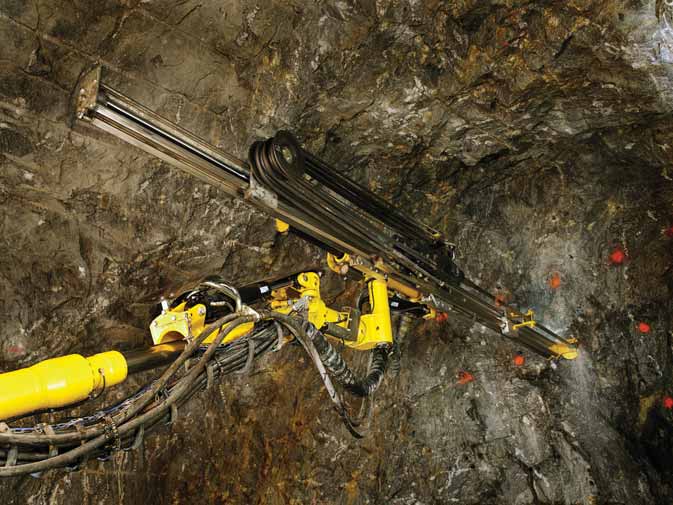
Careful setup—proper collaring and alignment—is the key to achieving successful drill program results.
Underground Drilling: Best Practice, Better Tools
For both production and development drilling precision is crucial for blasting and
drill string cost control is essential for good economy

Production Drilling Options
For any mining method successful realization
of the designed production drill
plan in the rock requires selection of the
most appropriate drilling system to
achieve the necessary precision and
skilled use of the equipment by the
driller. Typically the system choice will
be between top hammer and in-the-hole
(ITH) drilling. In both cases careful setup
is the essential first step: the holes
must be collared in exactly the right position
and correctly aligned. They can then
be drilled in the intended direction and
to the exact depth indicated in the drill
plan. According to Atlas Copco, precision
in collaring and hole alignment can be
achieved with proper surveying and
mark-ups of the drill pattern grid, coupled
with a drill angle indicator mounted
on the drill feed and a hole depth instrument.
It is also essential to have a good
view of the collaring procedure from the
operator’s cabin. Sophisticated computerized
methods can also help locate the
drill rig precisely according to a mine’s
co-ordinates.
Once the driller is engaged with the rock mass and its peculiarities, the main obstacle to achieving the straight hole that reaches the intended depth is usually in-hole deviation during drilling, normally caused by the particular geological characteristics of the rock mass, such as grain size, bedding and the degree of fracturing and foliation. The degree of deviation likely to be encountered in a given rock mass and its impact on the preferred mining method will usually influence the choice of down-the-hole/inthe- hole (DTH/ITH) equipment or top hammer drilling. The key advantage of ITH is its ability to drill straight holes— normally the in-hole deviation is maintained within +/-0.5% (max +/-1%). Top hammer drilling is more likely to be affected by in-hole deviation, especially in long holes, but has the advantage in terms of penetration rate and other parameters. In addition, since a mine will normally use top hammer equipped face drilling rigs for development drilling, rock bolting etc, there are advantages to using top hammer rigs and tools for both production and development.
ITH Practicalities
The DTH/ ITH drill quickly became popular
for production drilling in open stoping,
especially in Canada, and could be
used for drilling up holes as well as down
holes. Assuming two or three shifts/day, a
single rig has a capacity of about
60,000-80,000 drilled m/y, depending
on conditions, so yield per rig can easily
exceed 1 million m3. Therefore, to obtain
high utilization a certain scale of mining
is required. The straight holes capability
means that ITH rigs can be employed in
large-scale mines to drill hole lengths up
to 75 m, for instance at El Soldado in
Chile and Mount Isa in Australia, with
negligible deviation. This degree of accuracy
allows mines to space sub-levels further
apart, providing substantial savings
on the development of drilling drifts.
However, the orebodies mined must be
large, with regular ore/waste boundaries.
Less deviation also means better controlled
fragmentation of blasted material,
resulting in less drawpoint hang-ups, less
secondary breaking, fewer ore pass and
chute hang-ups, and better overall materials
handling economy. Opting for ITH
drilling challenges the mine planner to a
new dimension of stope design and
geometry, says Atlas Copco. As actual
versus designed hole pattern and location
coincides well, the ore/waste ratio can be
better controlled.
The penetration rate of ITH rock drills is almost proportional to the applied air pressure. As the hammer is always in direct contact with the bit, no percussive energy is lost in joints. Hence, the net penetration rate does not drop as the hole gets deeper. For top hammer drilling, about 2%-3% of the percussive energy is lost at every additional rod joint. On the other hand, since water mist drilling is necessary underground for dust suppression, there is a net penetration loss of some 20% compared with dry drilling on the surface.
Atlas Copco lists other operational advantages enjoyed by ITH drilling as: more precise development of longhole raises; reduced risk of getting stuck in fractured and faulted rock conditions; the lower noise level at the worksite because the hammer is working inside the hole, close to the bit; and the simplicity of operation, service and maintenance, which normally translates to high availability of the equipment.
But, as well as drilling speed, there are other downsides to ITH. Using the system for production drilling in conjunction with top hammer development drilling has additional costs, such as installation of 6-25 bar compressed air pipes on the drilling level to provide the required pressure boost, and high air consumption. Furthermore, says Atlas Copco, the larger holes drilled by ITH rigs—from 90-254 mm, with a normal range of 110-178 mm—compared with top hammers at 51- 102 mm mean more explosives are used per meter of hole. In turn, as a rule of thumb, for every additional 25 mm of hole diameter, the cracks after detonation migrate one more meter. As a result, drawpoint brows and sidewalls in pillars may be overblasted and cracked. Also, lower down the mining scale, irregular, narrow orebodies cannot take advantage of the longer and larger diameter holes.
Minimizing Top Hammer Negatives
While a top hammer and standard drill
string can penetrate homogenous rock with
little or no deviation, this is not the case
where the rock mass is bedded and has
been subject to any of foliation, jointing,
fracture or the creation of voids. Typically
in-hole deviation limits the practical hole
length that can be drilled with a top hammer.
It is often claimed that the amount of
deviation is proportional to the depth
squared. As the magnitude of deviation is
exponential to the hole length, tophammer
holes are often restricted to around 30 m. Penetrating structured rock with strong
foliation and bedding properties can cause
deviations of up to 5%-10%.
In Atlas Copco’s experience many mines consequently avoid drilling holes deeper than 20 m. But where these limitations either do not compromise the choice of mining method at all or do so to only a limited extent, the balance of advantage frequently favors using top hammer rather than ITH drills. To improve the position further, equipment manufacturers have put a lot of effort into minimizing deviation when using top hammers. As well as designing a range of drill rigs to cover the full scope of top hammer applications, these companies have optimized rock drills, drill string elements and bits to minimize inhole deviation in a wide variety of geological environments.
Rock drill factors
During the drilling operation, above a certain
drill rotation rate, the friction generated
between the drill bit and the rock
induces a torque in the drill string. The
larger the drill string diameter and the
greater the rotation rate, the higher the
necessary torque, and thus the feed force
that the rock drill must deliver to keep
the drill string joints sufficiently well
tightened.
Even so, at particular points along the hole, the drill string will buckle, so that rather than being straight in the hole it is supported by the hole wall. This occurs first close to the midpoint between rock drill and the hole bottom. Thus, explains Atlas Copco, for a COP 1838ME rock drill with a drill string diameter of 38 mm and a feed force of 6,400 N at a percussive pressure of 200 bar, this bending length is approximately 11 m. In practice, bending usually occurs at a somewhat shorter interval since the drill string is not perfectly straight when drilling starts. When the drill string has been extended to twice the theoretical bending length, it will buckle once more, and so on with increasing hole depth.
Assuming the same combination of drill string, impact force and rotation rate, modern high powered rock drills with ‘floating dampers’ require less feed force to keep the drill string joints well tightened than those rock drills incorporating ‘fixed dampers.’ Those rock drills with an axial bearing between the drill string and the machine require the greatest feed force to maintain joint tightness. Less deviation can be achieved through a combination of reduced feed force and increased rotation speed.
Bit and steel selection
The initial geometry of the drill bit face
and its worn condition also influence
hole deviation. So does the diameter of
the drill string.
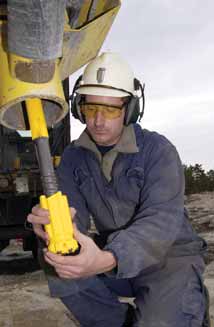
One way to minimize wiggling is to use Retrac bits. Characterized by a bit skirt with the same outer diameter as the bit head, Retrac bits were developed primarily to improve retraction of the drill string in difficult rock conditions where jamming tends to occur. Debris from the hole is flushed through slots machined along the bit, and the rear end of the skirt has a cutting edge between every slot. Since the Retrac bit cannot wiggle as much as a standard bit (with a skirt that is significantly smaller than the bit head) hole straightness is improved.
Other things being equal, the larger the diameter of the drill string employed, the straighter the drill hole achieved. This is because the drill string diameter has more of an influence on the bending length than the feed force. A larger diameter drill string also reduces the risk of wiggling (i.e. the ratio between the maximum bending moment of the drill string and the bending moment at which bending occurs) so that less careful regrinding can be tolerated before wiggling sets in. Atlas Copco sternly emphasizes that this does not mean larger string diameters should be deployed in preference to less careful grinding.
This diameter advantage influenced the development and industry take-up of drill tubes. A complete drill string of tubes may also be necessary in downward production drilling underground in order to achieve sufficient flushing capacity. However, tubes are expensive and an attractive alternative is the use of a guide tube connected to the drill bit, which, owing to its larger diameter, reduces the possible amplitude of drill bit wiggle compared with rods. As the possible angle of wiggling decreases with increasing length of the guide tube, the guide tube incorporated into the drill bit should be as long as possible. Unlike an all-tube drill string, where the stress waves are transmitted via “shoulder impact,” stress waves in a drill string incorporating a guide tube are transmitted down the rods to the guide tube via bottom impact. This means the guide tube does not suffer from premature female thread failure. Even though a guide tube will always result in a marginal decrease in drilling rate (depending only on the cross sectional area increase relative to the rods in the rest of the drill string, rather than the drill tube length), the improved hole straightness achieved is normally of greater value to the mining engineer. Using long guide tubes will normally result in straighter holes than those drilled using Retrac bits.
The bending length discussed above relates only to vertical holes. In slanted holes, the weight of the drill string also gives rise to bending, so that the drill string is never straight, and, as with rotational influences, results in a shortening of the theoretical bending length as the hole approaches horizontal. However, in benching and production drilling underground, the holes are almost vertical and the effect of drill hole angle is normally negligible. Another relatively uncommon source of in-hole deviation is resonance vibration, which may theoretically be initiated by the periodic load created when the rock drill piston subjects the drill string to a pulsed axial stress. This vibration can result in plastic deformation of the drill string close to the joints. This phenomenon is very rare, however, owing to the fact that the boundary condition between the bit and the rock is never constant. Also, as soon as the drill string length is greater than the theoretical bending length, it will be supported by the hole wall at one or more points along its length, thereby inhibiting resonance vibration.
Probably the key governing measure in choosing drill type for a specific job is how much in-hole deviation can be accepted for successful blasting results. And, of course, both ITH and top hammer methods can be used in one mine and for one mining method. Atlas Copco cites the example of El Soldado in Chile, where 64-mm tophammer drilling is used for establishing the trough undercuts, combined with 165-mm ITH drilling for downhole bench drilling from the sub level above. In order to get best usage of the larger holes, the layout of this level resembles a surface bench used at quarries and open-pits.
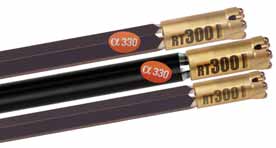
Bits: the bigger picture
Bit costs are significant; drill bits are not
cheap. According to Sandvik, it is the
hidden costs of bit failure that really concern
large-scale miners and contractors.
The drill bit, literally, is the spearhead of
production. When it fails, a large and
expensive rig is the first machine to fall
idle. The operator must switch off rotation,
apply a special feed-percussion
technique to loosen the bit-thread, stop
the rock drill—on each boom if it is a 2-
or-more boom jumbo—climb down from
the rig, check that the drift or tunnel roof
is safe, walk to the front of the rig,
remove the broken bit and replace it with
a new one. A skilled operator can achieve
this in five to seven minutes but must
then go back to the controls, restart the
machine, switch on rotation and flushing,
feed the drillstring back into the hole,
switch on the percussion and start the
collaring sequence on both booms. Only
then can the percussion pressure be
ramped up to resume full-power drilling.
Before you know it, 15 minutes of production
has been lost. In mining and
even more so in construction, that is a
lot. And it would be naive to think that
the delay, caused by one inferior drill bit,
will not, in one way or another, have a
knock-on effect all the way up the production
chain.
In the bigger picture therefore, Sandvik (which has been a world leader in cemented carbide production longer than it has been a drill rig and rock drill manufacturer) argues, the price of the drill bit becomes almost unimportant: it is quality that counts. The firm says that its technology development work has consistently found new ways to achieve a better balance between the key properties of hardness and wear resistance on the one hand and toughness–resilience on the other. The result has been a continual improvement in bit penetration rate performance and service life. The company’s latest introduction is the RT300-series of bits for drifting and tunneling.
Curiously, Sandvik says, service life has less to do with rock hardness than one might expect. The life of drill bits of uniform quality can vary enormously with the rock formation, but not necessarily on account of the rock hardness. According to Sandvik Market-Support Engineer Robert Olsson, Sandvik CAPP button bits, the predecessors to the RT300 series, routinely lasted for more than 700 m in hard rock at a worksite in Norway, where a lot of tunneling is done. In Swedish granite, a common benchmark, the same bits averaged about 400 m. By any standard, that is good bit life. But then, in another application in Australia, the life of the very same bits was less than 100 m. The point, says Olsson, is that the rock in Sweden was just as hard as, and perhaps even more abrasive than, the rock in Australia. So what other factors can be at play?
Kenneth Larsson, a senior developer with Sandvik, puts it this way: button failure is caused by overloading; pure and simple. But with Sandvik drill bits, damage from frontal overloading is rare. “It is the shear stresses generated by side forces that cause the most damage,” he said. And the thing about side forces is that they are not normally very great in competent rock, no matter how hard. But as soon as you drill into a crack or fracture, the distribution of load on the drill bit becomes irregular and erratic. Only part of the face of the bit is loaded reactively by the rock, while shear stresses can stem from just one or two jagged areas on the periphery of the hole, changing all the time. This is easy to understand if you can imagine how a crack tries to steer a drill bit off course. Naturally, it causes uneven loading of the gauge buttons. All the gauge buttons feel the stress because the drill bit is rotating. But they do not feel it at the same time, for the load is not distributed evenly around the periphery of the bit. It is this imbalance that causes acute overloading.
Another factor is gauge wear in abrasive rock. Drill bits are normally tapered backward from the face of the bit. When gauge wear is high, the bit can develop a taper in the opposite direction, toward the face. This anti-taper, as it is called, invites increasingly high side forces on to the gauge buttons and is a common cause of button failure. While the antitaper can be corrected to some extent by gauge grinding, the real need is for buttons with higher resilience and strength.
For RT300 bits, Sandvik has developed what it believes to be the optimum cemented-carbide buttons for drilling a very broad range of rocks—the widest yet. Grade XT48, where the XT stands for Extra Tough, is a true multi-purpose hard-metal for rock bits. What distinguishes it from other grades of cemented carbide—and this, said the manufacturer, is a first—is that its toughness has been increased without compromising its very high resistance to wear. Grade XT48 is the first in a new family of grades which, thanks to the introduction of new techniques, have higher density and a more homogenous structure, making the buttons even stronger than before. In parallel, Sandvik has improved almost every other step in its bit manufacturing process, resulting in the unprecedented all-round quality of the new RT300-series bits.
Cemented-carbide specialist Torbjörn Hartzell, who works with hard material development at Sandvik, adds that in fractured, cracked and abrasive rock RT300-series drill bits dramatically increase their lead over all others. “In some rock formations, strong side forces and shear stresses are unavoidable,” he said.” But since we have perfected the technique of making buttons even denser and more homogenous, we have made them stronger than ever. When you add to this strength and wear-resistance the extra toughness we have achieved in grade XT48 buttons, you can see why the new RT300-series drill bits are so much better.”
Sandvik reports that at one of the world’s largest base metal mines, long notorious for button breakages, RT300- series drill bits are giving more than double the service life of the bits used previously. In a large-scale test, stoppages are down, productivity is up and bit costs have been halved. Mine management has welcomed the news and is expected shortly to extend the use of RT300 throughout the mine. Rig operators, too, are happier. According to the local Sandvik service manager, when drillers have productivity targets and bonuses in mind, “nothing annoys them more than bit failures.”
While the results from the mine are indisputable, Olsson said not every worksite can expect such a dramatic improvement. “If button failure is a problem in your rock formation, then, certainly, you will see a big increase in bit life with Sandvik RT300. But even if button breakage is not a problem in your rock, you can still expect a 10% to 20% increase in bit life, compared with current Sandvik drill bits.”
Manufactured in diameters from 35 to 51 mm, Sandvik RT300-series bits for drifting and tunneling are available for tool systems with thread types R25, Sandvik Alpha 250, R28, Sandvik Alpha 280, R32, Sandvik Alpha 330, Sandvik R35 and Sandvik T35.
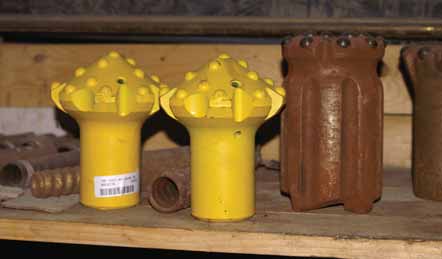
The solution developed by Atlas Copco Secoroc (now Atlas Copco Rock Drilling Technique) retained the hole size matches provided by conventional drill rods and easy uncoupling of the bit but featured a new thread design. The first in the Magnum SR product family was the SR35, introduced six years ago, which is 35 mm in diameter at the end of the thread and 32 mm at its tip. Atlas Copco says the addition of 25% more steel at the end of the thread has increased the fatigue resistance of the rods and reduced the tendency to deviate during collaring, as well as creating a distinctive conical shape. Tests around the world in mines and tunneling projects showed that, relative to the R32 equivalents, the Magnum SR system increased rod service life by 25%–100% and also improved bit life.
The SR35 system includes standard and Speedrod hexagonal 35mm rods and 39 mm round standard and Speedrods in lengths from 3.1 to 6.1 m lengths. The SR35 Focus button bits range from 43 to 64 mm and reaming equipment includes pilot adapters and reaming bits as well as the Dome bit. This latter bit is used for single step drilling of the cut hole, taking a shorter total time compared with conventional reaming equipment.
Subsequently Atlas Copco added the SR28 range for rockbolt and other small hole drilling and the SR32, which is designed for hole diameters of 38– to 41– mm, to the Magnum family and later the SR22, SR25 and SR38. So the systems now cover hole diameters 32– to 51– mm for blastholes and bolting, 51– to 64– mm for grouting, and 76– to 127– mm dome bits for reaming.
Sandvik introduced the Alpha 330 tool system in 2003 to replace R32 rods in high power drilling and more recently added the Alpha 280 and 250 28- and 25-mm tool systems based on the same concept—which provides both a stronger rod and a guiding function between the rod and the bit skirt. The company has reported considerable cost savings by using the system (E&MJ, October 2006, p. 54).
New Rock Drills
As well as the 22-kW COP 2238 hydraulic
rock drill for the 51– to 76– mm hole
diameter range and the COP 1240 DTH
rock drill for surface mining and quarrying
use that E&MJ reviewed in the October
2007 issue (p. 86), Atlas Copco also introduced
new DTH hammers for deep-hole
and waterwell drilling earlier this year.
The Secoroc TD40 DTH hammer has been designed for drilling companies meeting the rapidly increasing demand for geothermal heating system holes. To find sufficient energy in the bedrock, these wells are often deeper than 200 m and are invariably filled with water. The driller needs equipment that can drill deep quickly without being effected by the backpressure of the water. The TD 40 is Atlas Copco’s solution.
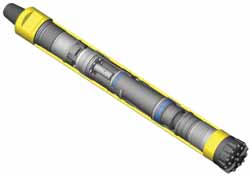
The new design has not meant sacrificing performance, Atlas Copco claims. The Aqua’s drilling ability is as high as any oil-lubricated Secoroc 6–in. DTH hammer, such as the COP 64 or the QL 60. Maintenance is also very simple, requiring only changing the drill’s specially designed wear bands at regular intervals to retain high drill performance throughout the service life of the hammer. Should the hammer be used only sporadically, a few drops of COP Oil or any other environmentally friendly hammer oil are added to keep the components in pristine condition. Blowing air through the hammer for 60 seconds prior to drilling again cleans away any oil.
The Secoroc Aqua 60 has been tried and tested in North America with excellent results and is now available worldwide together with the wide range of Secoroc Premium Plus drill bits.